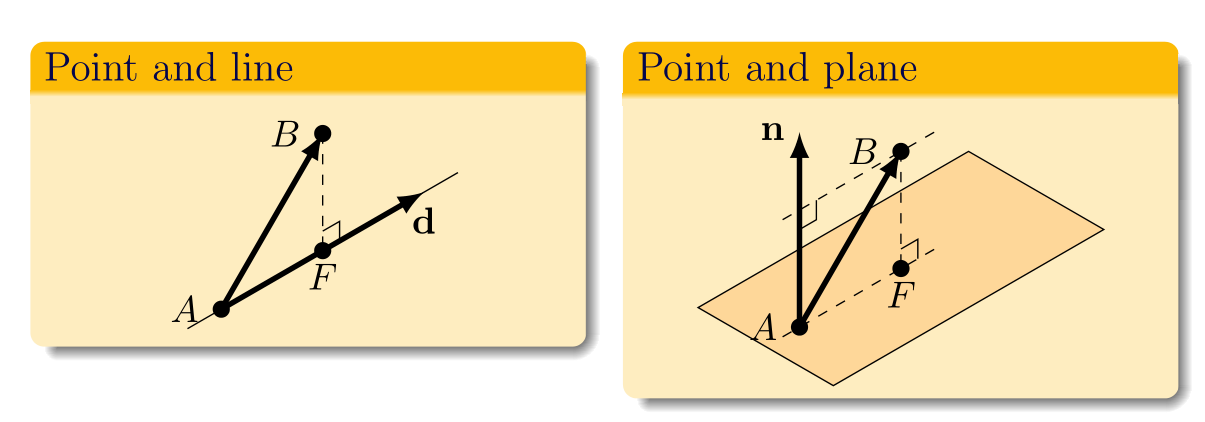In my video (link to be updated) I have worked out examples of how to use projection vectors to find the foot of perpendicular (for both lines and planes). The benefits of this method
- it is faster,
- it uses a similar concept for both lines and planes with slight modifications.
The downsides, however, is that it involves a rather unwieldy projection vector formula $(\mathbf{a}\cdot\mathbf{\hat{b}}) \mathbf{\hat{b}}$ and that minor details make a huge difference to whether we get the correct answer (e.g. where are our vectors pointing, $\overrightarrow{AB}$ or $\overrightarrow{BA}$? Is our final projection vector $\overrightarrow{AF}$ or $\overrightarrow{FB}$?).
In this post I will offer an alternative method to find foot of perpendicular using earlier concepts that some students find easier to understand.
Finding foot of perpendicular to a line
We will use the example of finding the foot of perpendicular, $F$ from $B(4,6,-1)$ to the line $$l: \mathbf{r} = \begin{pmatrix} -1 \\ 5 \\ -3 \end{pmatrix} + \lambda \begin{pmatrix} 1 \\ -1 \\ 1 \end{pmatrix}, \lambda \in \mathbb{R}.$$
There are two key ideas behind this approach:
- $F$ lies on the line: hence we can use the equation of the line
- $BF$ is perpendicular to the line: hence $\overrightarrow{BF}\cdot \mathbf{d} = 0$.
Since $F$ lies on the line, we can use the equation of the line and write $$\overrightarrow{OF} = \begin{pmatrix} -1+\lambda \\ 5-\lambda \\ -3+\lambda \end{pmatrix}$$ We next find $\overrightarrow{BF} = \overrightarrow{OF} - \overrightarrow{OB} = \begin{pmatrix} -5+\lambda \\ 1-\lambda \\ 2+\lambda \end{pmatrix}$.
Since $BF$ is perpendicular to the line, $\overrightarrow{BF}$ is perpendicular to the direction vector of the line. \begin{gather} \overrightarrow{BF} \cdot \mathbf{d} = 0 \\ \begin{pmatrix} -5+\lambda \\ -1-\lambda \\ -2+\lambda \end{pmatrix} \cdot \begin{pmatrix} 1 \\ -1 \\ 1 \end{pmatrix} = 0 \\ -6+3\lambda = 0 \\ \lambda = 2 \end{gather} Substituting that back into the equation for $\overrightarrow{OF}$ gives us $\overrightarrow{OF} = \begin{pmatrix} 1 \\ 3 \\ -1 \end{pmatrix}$.
Finding foot of perpendicular to a plane
We will use the example of finding the foot of perpendicular, $F$ from $B(4,6,-1)$ to the plane $$p: \mathbf{r} \cdot \begin{pmatrix} 1 \\ 1 \\ 0 \end{pmatrix} = 4.$$
There are two key ideas behind this approach:
- We will form the equation of the line $BF$, noting that it is parallel to the normal vector of the plane.
- The intersection point between the line $BF$ and the plane is the foot of perpendicular $F$.
To form an equation for the line $BF$, we note that $B$ lies on the line and the normal vector of the plane is the direction vector of the line. Thus $$l_{BF}: \mathbf{r} = \begin{pmatrix} 4 \\ 6 \\ -1 \end{pmatrix} + \lambda \begin{pmatrix} 1 \\ 1 \\ 0 \end{pmatrix}, \lambda \in \mathbb{R}.$$ Take note to not confuse the line $BF$ and the vector $\overrightarrow{BF}$.
$F$ is the point of intersection between $l_{BF}$ and the plane $p$. We thus substitute the equation of the line into the plane: \begin{gather} \begin{pmatrix} 4+\lambda \\ 6+\lambda \\ -1 \end{pmatrix} \cdot \begin{pmatrix} 1 \\ 1 \\ 0 \end{pmatrix} = 4 \\ 10+2\lambda = 4 \\ \lambda = -3 \end{gather} Substituting that back into the equation of the line gives us $\overrightarrow{OF} = \begin{pmatrix} 1 \\ 3 \\ -1 \end{pmatrix}$.




You must be logged in to post a comment.